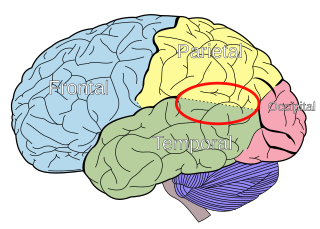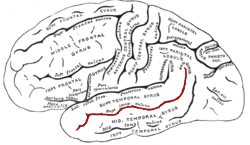Related Research Articles
Social cognition is a topic within psychology that focuses on how people process, store, and apply information about other people and social situations. It focuses on the role that cognitive processes play in social interactions.
In psychology, theory of mind refers to the capacity to understand other people by ascribing mental states to them. A theory of mind includes the knowledge that others' beliefs, desires, intentions, emotions, and thoughts may be different from one's own. Possessing a functional theory of mind is considered crucial for success in everyday human social interactions. People utilise a theory of mind when analyzing, judging, and inferring others' behaviors. The discovery and development of theory of mind primarily came from studies done with animals and infants. Factors including drug and alcohol consumption, language development, cognitive delays, age, and culture can affect a person's capacity to display theory of mind. Having a theory of mind is similar to but not identical with having the capacity for empathy or sympathy.

Brodmann area 9, or BA9, refers to a cytoarchitecturally defined portion of the frontal cortex in the brain of humans and other primates. It contributes to the dorsolateral and medial prefrontal cortex.

Sir Simon Philip Baron-Cohen is a British clinical psychologist and professor of developmental psychopathology at the University of Cambridge. He is the director of the university's Autism Research Centre and a Fellow of Trinity College. In 1985, Baron-Cohen formulated the mindblindness theory of autism, the evidence for which he collated and published in 1995. In 1997, he formulated the foetal sex steroid theory of autism, the key test of which was published in 2015.
A mirror neuron is a neuron that fires both when an organism acts and when the organism observes the same action performed by another. Thus, the neuron "mirrors" the behavior of the other, as though the observer were itself acting. Mirror neurons are not always physiologically distinct from other types of neurons in the brain; their main differentiating factor is their response patterns. By this definition, such neurons have been directly observed in humans and primate species, and in birds.
Mind-blindness, mindblindness or mind blindness is a theory initially proposed in 1990 that claims that all autistic people have a lack or developmental delay of theory of mind (ToM), meaning they are unable to attribute mental states to others. According to the theory, a lack of ToM is considered equivalent to a lack of both cognitive and affective empathy. In the context of the theory, mind-blindness implies being unable to predict behavior and attribute mental states including beliefs, desires, emotions, or intentions of other people. The mind-blindness theory asserts that children who delay in this development will often develop autism.
Cognitive specialization suggests that certain behaviors, often in the domain of social communication, are passed on to offspring and refined to be maximally beneficial by the process of natural selection. Specializations serve an adaptive purpose for an organism by allowing the organism to be better suited for its habitat. Over time, specializations often become essential to the species' continued survival. Cognitive specialization in humans has been thought to underlie the acquisition, development, and evolution of language, theory of mind, and specific social skills such as trust and reciprocity. These specializations are considered to be critical to the survival of the species, even though there are successful individuals who lack certain specializations, including those diagnosed with autism spectrum disorder or who lack language abilities. Cognitive specialization is also believed to underlie adaptive behaviors such as self-awareness, navigation, and problem solving skills in several animal species such as chimpanzees and bottlenose dolphins.

The fusiform face area is a part of the human visual system that is specialized for facial recognition. It is located in the inferior temporal cortex (IT), in the fusiform gyrus.

Henry John Markram is a South African-born Israeli neuroscientist, professor at the École Polytechnique Fédérale de Lausanne (EPFL) in Switzerland and director of the Blue Brain Project and founder of the Human Brain Project.

The temporoparietal junction (TPJ) is an area of the brain where the temporal and parietal lobes meet, at the posterior end of the lateral sulcus. The TPJ incorporates information from the thalamus and the limbic system as well as from the visual, auditory, and somatosensory systems. The TPJ also integrates information from both the external environment as well as from within the body. The TPJ is responsible for collecting all of this information and then processing it.

In neuroscience, the default mode network (DMN), also known as the default network, default state network, or anatomically the medial frontoparietal network (M-FPN), is a large-scale brain network primarily composed of the dorsal medial prefrontal cortex, posterior cingulate cortex, precuneus and angular gyrus. It is best known for being active when a person is not focused on the outside world and the brain is at wakeful rest, such as during daydreaming and mind-wandering. It can also be active during detailed thoughts related to external task performance. Other times that the DMN is active include when the individual is thinking about others, thinking about themselves, remembering the past, and planning for the future.

In the human brain, the superior temporal sulcus (STS) is the sulcus separating the superior temporal gyrus from the middle temporal gyrus in the temporal lobe of the brain. A sulcus is a deep groove that curves into the largest part of the brain, the cerebrum, and a gyrus is a ridge that curves outward of the cerebrum.
Michael Steven Anthony Graziano is an American scientist and novelist who is currently a professor of Psychology and Neuroscience at Princeton University. His scientific research focuses on the brain basis of awareness. He has proposed the "attention schema" theory, an explanation of how, and for what adaptive advantage, brains attribute the property of awareness to themselves. His previous work focused on how the cerebral cortex monitors the space around the body and controls movement within that space. Notably he has suggested that the classical map of the body in motor cortex, the homunculus, is not correct and is better described as a map of complex actions that make up the behavioral repertoire. His publications on this topic have had a widespread impact among neuroscientists but have also generated controversy. His novels rely partly on his background in psychology and are known for surrealism or magic realism. Graziano also composes music including symphonies and string quartets.
S.M., sometimes referred to as SM-046, is an American woman with a peculiar type of brain damage that dramatically reduces her ability to feel fear. First described by scientists in 1994, she has had exclusive and complete bilateral amygdala destruction since late childhood as a consequence of Urbach–Wiethe disease. Dubbed by the media as the "woman with no fear", S.M. has been studied extensively in scientific research; she has helped researchers elucidate the function of the amygdala.
Large-scale brain networks are collections of widespread brain regions showing functional connectivity by statistical analysis of the fMRI BOLD signal or other recording methods such as EEG, PET and MEG. An emerging paradigm in neuroscience is that cognitive tasks are performed not by individual brain regions working in isolation but by networks consisting of several discrete brain regions that are said to be "functionally connected". Functional connectivity networks may be found using algorithms such as cluster analysis, spatial independent component analysis (ICA), seed based, and others. Synchronized brain regions may also be identified using long-range synchronization of the EEG, MEG, or other dynamic brain signals.

The dorsomedial prefrontal cortex (dmPFC or DMPFC is a section of the prefrontal cortex in some species' brain anatomy. It includes portions of Brodmann areas BA8, BA9, BA10, BA24 and BA32, although some authors identify it specifically with BA8 and BA9. Some notable sub-components include the dorsal anterior cingulate cortex, the prelimbic cortex, and the infralimbic cortex.

The salience network (SN), also known anatomically as the midcingulo-insular network (M-CIN) or ventral attention network, is a large scale network of the human brain that is primarily composed of the anterior insula (AI) and dorsal anterior cingulate cortex (dACC). It is involved in detecting and filtering salient stimuli, as well as in recruiting relevant functional networks. Together with its interconnected brain networks, the SN contributes to a variety of complex functions, including communication, social behavior, and self-awareness through the integration of sensory, emotional, and cognitive information.
Social cognitive neuroscience is the scientific study of the biological processes underpinning social cognition. Specifically, it uses the tools of neuroscience to study "the mental mechanisms that create, frame, regulate, and respond to our experience of the social world". Social cognitive neuroscience uses the epistemological foundations of cognitive neuroscience, and is closely related to social neuroscience. Social cognitive neuroscience employs human neuroimaging, typically using functional magnetic resonance imaging (fMRI). Human brain stimulation techniques such as transcranial magnetic stimulation and transcranial direct-current stimulation are also used. In nonhuman animals, direct electrophysiological recordings and electrical stimulation of single cells and neuronal populations are utilized for investigating lower-level social cognitive processes.
Leah H. Somerville is an American psychologist who is a professor at Harvard University. She is a member of the Human Connectome Project. Somerville was awarded the 2022 National Academy of Sciences Troland Research Award.

In psychology, self-other control, also known as self-other distinction, denotes the capacity to discern between one's own and other individuals' physical and mental states — actions, perceptions, and emotions.
References
- ↑ "Jacqueline Lees and Rebecca Saxe named associate deans of science". 16 August 2021.
- ↑ Saxe, R.; Kanwisher, N. (2003). "People thinking about thinking people. The role of the temporo-parietal junction in "theory of mind"". NeuroImage. 19 (4): 1835–1842. doi:10.1016/S1053-8119(03)00230-1. PMID 12948738. S2CID 206118958.
- ↑ Young, L.; Camprodon, J. A.; Hauser, M.; Pascual-Leone, A.; Saxe, R. (2010). "Disruption of the right temporoparietal junction with transcranial magnetic stimulation reduces the role of beliefs in moral judgments". Proceedings of the National Academy of Sciences. 107 (15): 6753–6758. Bibcode:2010PNAS..107.6753Y. doi: 10.1073/pnas.0914826107 . PMC 2872442 . PMID 20351278.
- ↑ Moran, J. M.; Young, L. L.; Saxe, R.; Lee, S. M.; O'Young, D.; Mavros, P. L.; Gabrieli, J. D. (2011). "Impaired theory of mind for moral judgment in high-functioning autism". Proceedings of the National Academy of Sciences. 108 (7): 2688–2692. Bibcode:2011PNAS..108.2688M. doi: 10.1073/pnas.1011734108 . PMC 3041087 . PMID 21282628.
- ↑ Levenson, Thomas (20 February 2013). "The Story of a Study of the Mind". MIT Technology Review . Retrieved 9 November 2014.
- ↑ Humphries, Courtney (17 June 2014). "Hacking the Soul". MIT Technology Review . Retrieved 9 November 2014.
- ↑ Rad, Roya $. (21 May 2013). "The Brain of a Spiteful Person". Huffington Post . Retrieved 9 November 2014.
- ↑ Lewis, Susan K. (1 January 2008). "The Ape That Teaches". Nova . Retrieved 9 November 2014.
- ↑ Mikulak, Anna (2011). "An Intergenerational Conversation Between Mahzarin R. Banaji and Rebecca Saxe". Vol. 24, no. 6. Observer . Retrieved 9 November 2014.
- ↑ Bedny, M.; Pascual-Leone, A.; Dodell-Feder, D.; Fedorenko, E.; Saxe, R. (2011). "Language processing in the occipital cortex of congenitally blind adults". Proceedings of the National Academy of Sciences. 108 (11): 4429–4434. Bibcode:2011PNAS..108.4429B. doi: 10.1073/pnas.1014818108 . PMC 3060248 . PMID 21368161.
- ↑ Bruneau, E. G.; Pluta, A.; Saxe, R. (2012). "Distinct roles of the 'Shared Pain' and 'Theory of Mind' networks in processing others' emotional suffering". Neuropsychologia. 50 (2): 219–231. doi:10.1016/j.neuropsychologia.2011.11.008. PMID 22154962. S2CID 17953611.
- ↑ Bruneau, E. G.; Dufour, N.; Saxe, R. (2012). "Social cognition in members of conflict groups: Behavioural and neural responses in Arabs, Israelis and South Americans to each other's misfortunes". Philosophical Transactions of the Royal Society B: Biological Sciences. 367 (1589): 717–730. doi:10.1098/rstb.2011.0293. PMC 3260847 . PMID 22271787.
- ↑ Saxe, R.; Houlihan, S. D. (2017). "Formalizing emotion concepts within a Bayesian model of theory of mind". Current Opinion in Psychology. 17: 15–21. doi:10.1016/j.copsyc.2017.04.019. PMC 5637274 . PMID 28950962.